
- Introduction: An Overdue Trip To Kyoto
- Review: JetBlue Mint Business Class A321 (MIA-LAX)
- Review: Four Seasons Los Angeles At Beverly Hills
- Review: Starlux Airlines Business Class Airbus A350 (LAX-TPE)
- Review: Starlux Airlines Lounge Taipei Airport (TPE)
- Review: Starlux Airlines Business Class Airbus A330neo (TPE-KIX)
- Review: Park Hyatt Kyoto, Japan
- Review: Ritz-Carlton Kyoto, Japan
- Review: Four Seasons Kyoto, Japan
- Review: Shisui Nara, Marriott Luxury Collection
- Impressions From Our Trip To Kyoto, Japan
- Review: Japan Airlines Sakura Lounge Kansai Osaka Airport (KIX)
- Review: Japan Airlines Business Class Boeing 787 (KIX-LAX)
- Review: American Airlines Business Class Boeing 787 (LAX-MIA)
For the return portion of our trip to Kyoto, we flew Japan Airlines’ Boeing 787-9 business class from Osaka to Los Angeles. This is one of the few flights between Osaka and the United States mainland, so it sure is convenient to not have to make a detour through one of Tokyo’s airports.
While I’ve reviewed Japan Airlines’ 787-9 business class before, what made this flight different was that it was operated by an aircraft with a totally different hard product. While most of Japan Airlines’ long haul aircraft have Apex Suites, which are among the best business class seats out there, the airline also has some 787s and 777s that have reverse herringbone seats. Unfortunately this is an inferior product.
On the plus side, as you’d expect from a Japanese airline, the service was professional, the food and drinks were good, and there lots of amenities. Unfortunately this hard product really isn’t good, though, and it’s the worst reverse herringbone seat out there, in my opinion.
I have no regrets taking this flight, given the convenient schedule. However, on a route where there’s more competition, I’d probably avoid this aircraft if possible.
In this post:
How I booked our Japan Airlines business class tickets
I booked our Japan Airlines business class tickets using American AAdvantage miles. Specifically, I booked the following for 60,000 American AAdvantage miles plus $45.25 in taxes and fees per person:
10/07 JL60 Osaka to Los Angeles departing 5:45PM arriving 12:05PM
That’s a great deal, if you ask me. While AAdvantage isn’t as lucrative of a program as in the past, you still won’t get redemption values like that from Delta SkyMiles and United MileagePlus, so the program is a real competitive advantage, in my opinion.
Japan Airlines business class lounge & boarding
In the previous installment I reviewed the Japan Airlines Sakura Lounge at Kansai-Osaka Airport. Unfortunately it’s not a great lounge, so I wouldn’t plan on being there longer than you have to. Our flight was boarding from gate 31, a very short walk from the lounge. Boarding was scheduled for 5:20PM, just 25 minutes before departure — you’ve gotta love Japanese efficiency!
Well, or I guess there isn’t that much efficiency, because I counted a total of nine gate agents. I guess you’ve also gotta love Japanese staffing levels!

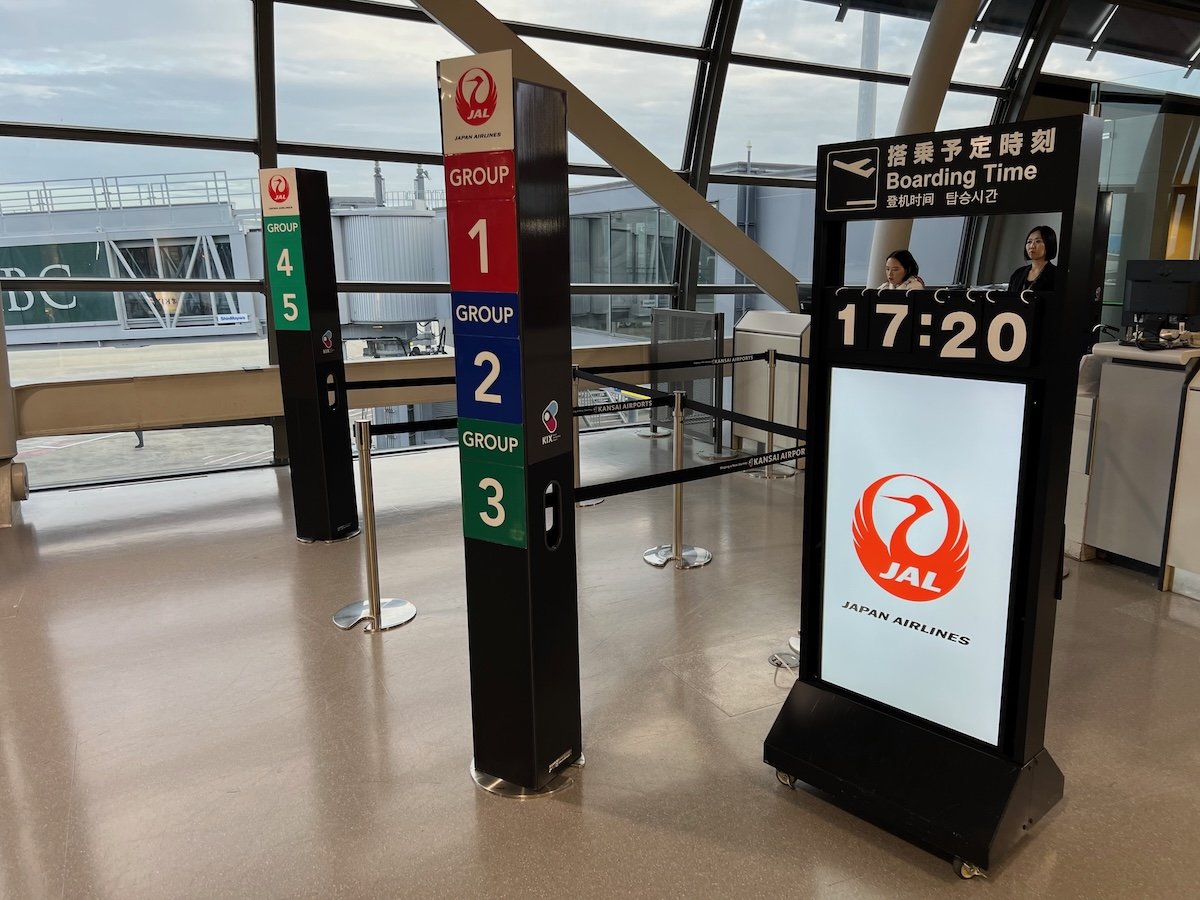
As you’d expect, boarding started exactly on-time (to the minute), with families and those needing extra time being invited to board first, followed by oneworld Emerald members, followed by business class passengers. Our flight would be operated by the 787-9 with the registration code JA877J, which joined Japan Airlines’ fleet in 2019.

Japan Airlines 787 business class cabin & seats
We boarded through the second set of doors, where we were greeted by the crew and directed left into the business class cabin. On this version of the 787-9, business class is exclusively between doors one and two, and consists of a total of 28 seats. Before we even talk about the seats, can we just acknowledge how bland Japan Airlines’ cabin finishes are? Could you pick duller finishes than this?

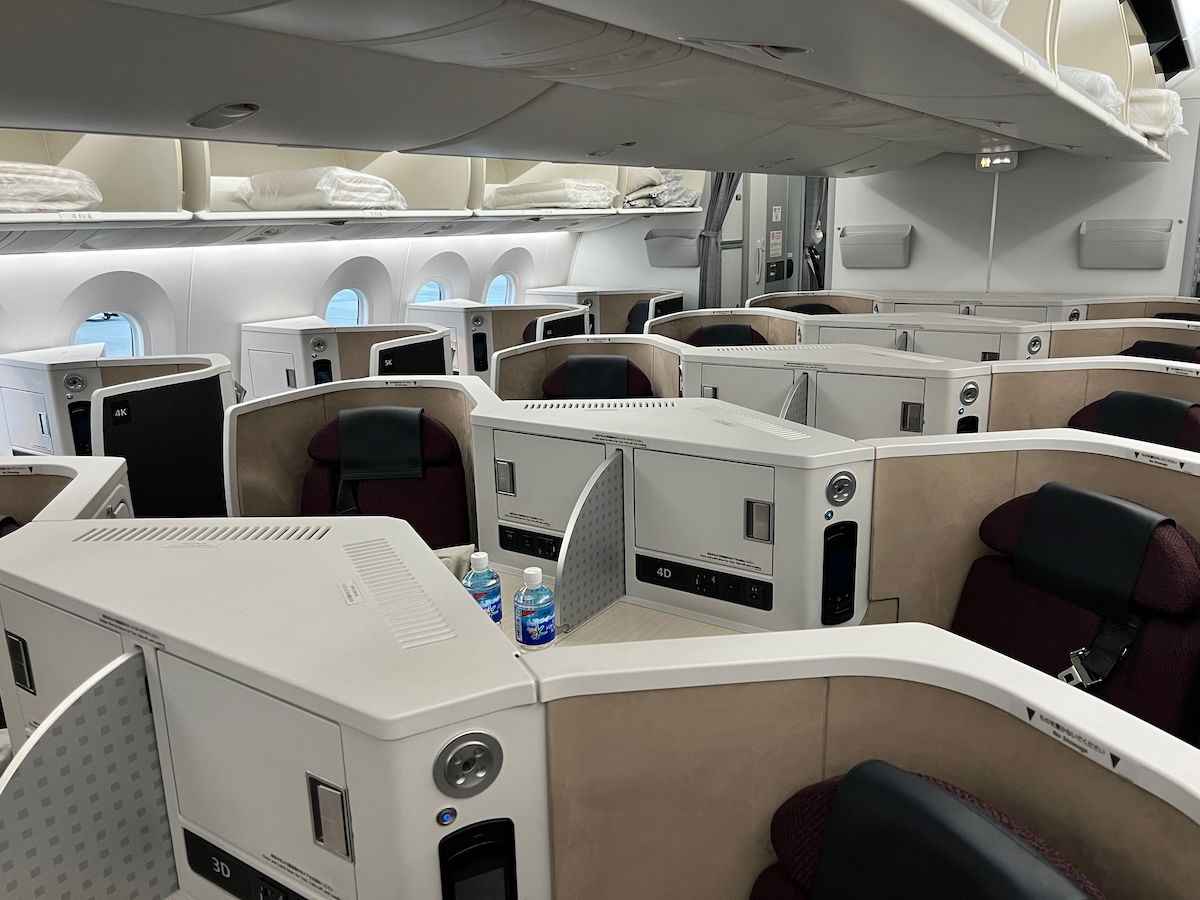
This aircraft had Japan Airlines’ Sky Suite III business class product, which is the Safran Aries seat. This consists of fully flat reverse herringbone seats, in a 1-2-1 configuration. Here’s the thing — usually I’m a fan of reverse herringbone seats, through the Safran Aries product is (to my knowledge) the densest reverse herringbone configuration out there, and you’ll feel that when you’re seated in this cabin.
Business class is spread across seven rows, and I assigned myself seat 7A, the window seat on the left side in the last row. Meanwhile I assigned Ford seat 6A.

The seat feels a bit narrower than your typical reverse herringbone seat, and the armrest on the window-side is also tiny.


To the left side of the seat was a counter where you could place things during the flight, as well as several of the seat’s other features.

There was a small enclosed storage compartment, featuring a hook for headphones, as well as a small mirror. Underneath that were the USB-A and AC power outlets, as well as the jack for headphones.

The controller could be used for the entertainment system, but was kind of unnecessary, since the entertainment is also touchscreen (if you can figure out how to actually activate the touchscreen mode, which is a challenge in and of itself).

Interestingly the seat controls were in a panel across from the seat by the aisle, which I’ve never seen before with any other product.

This product has an unconventional tray table design. The tray table doesn’t come out from the side of the seat or from underneath the entertainment screen (as is the case with most reverse herringbone products), but instead it folds down from the side of the seat in front.

Once you extend it, you’ll just want to change the angle, so that it can directly face you.

Along the right side of the seat, there’s an armrest that can be raised or lowered (it needs to be lowered for takeoff).
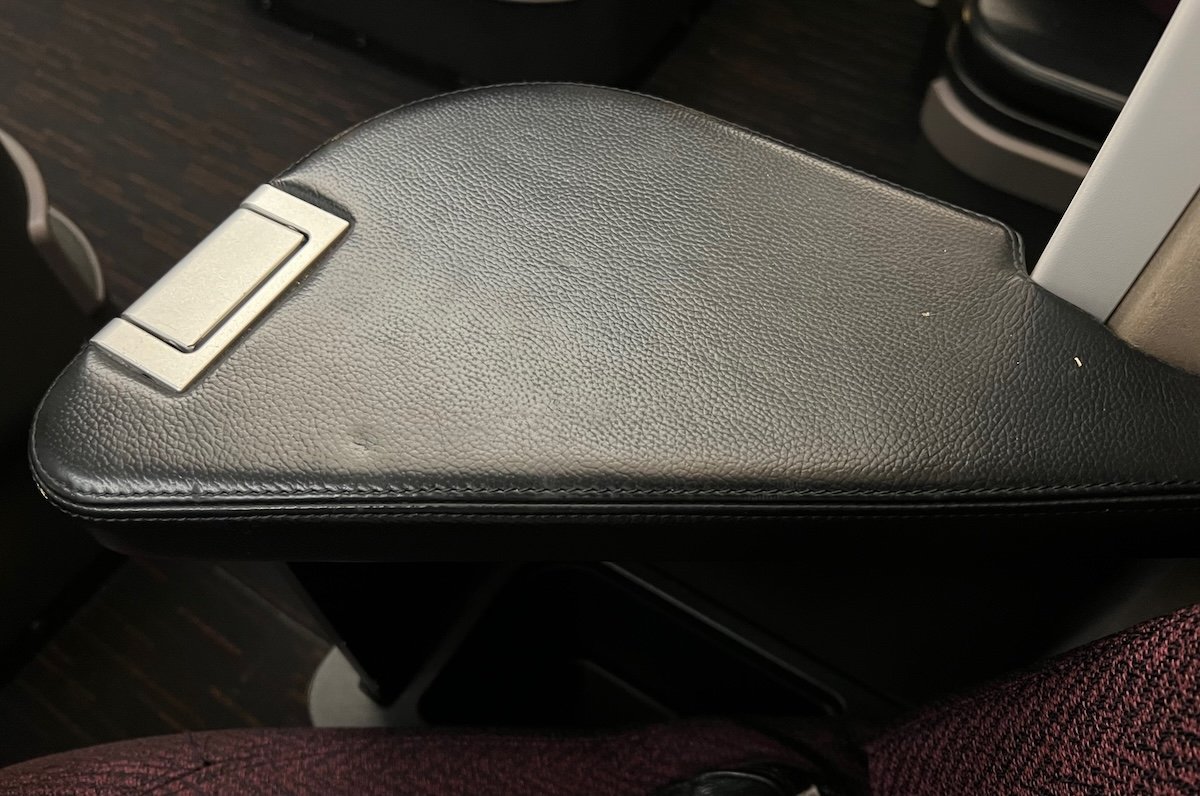
Often one of the issues with reverse herringbone seats is that you have to squeeze your feet into a small footwell. I didn’t find the footwell as such to be small, though the bigger issue was just how narrow the seat was when trying to sleep.

Unfortunately Japan Airlines doesn’t have individual air nozzles on its Boeing 787s. Usually Japan Airlines keeps its cabins quite warm, though fortunately on this flight, the cabin was kept at a surprisingly decent temperature.

In this configuration I’d highly recommend selecting a window seat. The center seats have significantly smaller footwells, and an odd layout. When you recline the center seats to bed mode, the adjacent seats are at a different height. This is so that their footwells can be stacked a bit, in order to save space. So when in bed mode, the person in the left center seat will be lower than the person in the right center seat.
I know the window seats in this configuration may not look that different from other reverse herringbone seats, but they are significantly tighter and less comfortable, and that’s especially apparent in bed mode (which I’ll talk more about later).
Japan Airlines business class amenities
We received a variety of amenities upon boarding. Waiting at our seats were a pillow and blanket, which were later complemented by a mattress pad. The blanket was fine, while the pillow was way too thin for my liking, as it provided very little support. It sure would be nice if Japan Airlines at least gave passengers the option of a thicker pillow, since I realize there are different cultural preferences there.

There was an amenity kit waiting at each seat, which was more like a thin pouch. It contained products like a dental kit, eyeshades, earplugs, a moisture mask, and tissues.

There were also a pair of slippers, which were better than nothing, but were very thin. They came with a shoehorn.

Then there were a pair of headphones, which were decent quality, though hurt my ears after a while.

There was also a bottle of water at each seat.
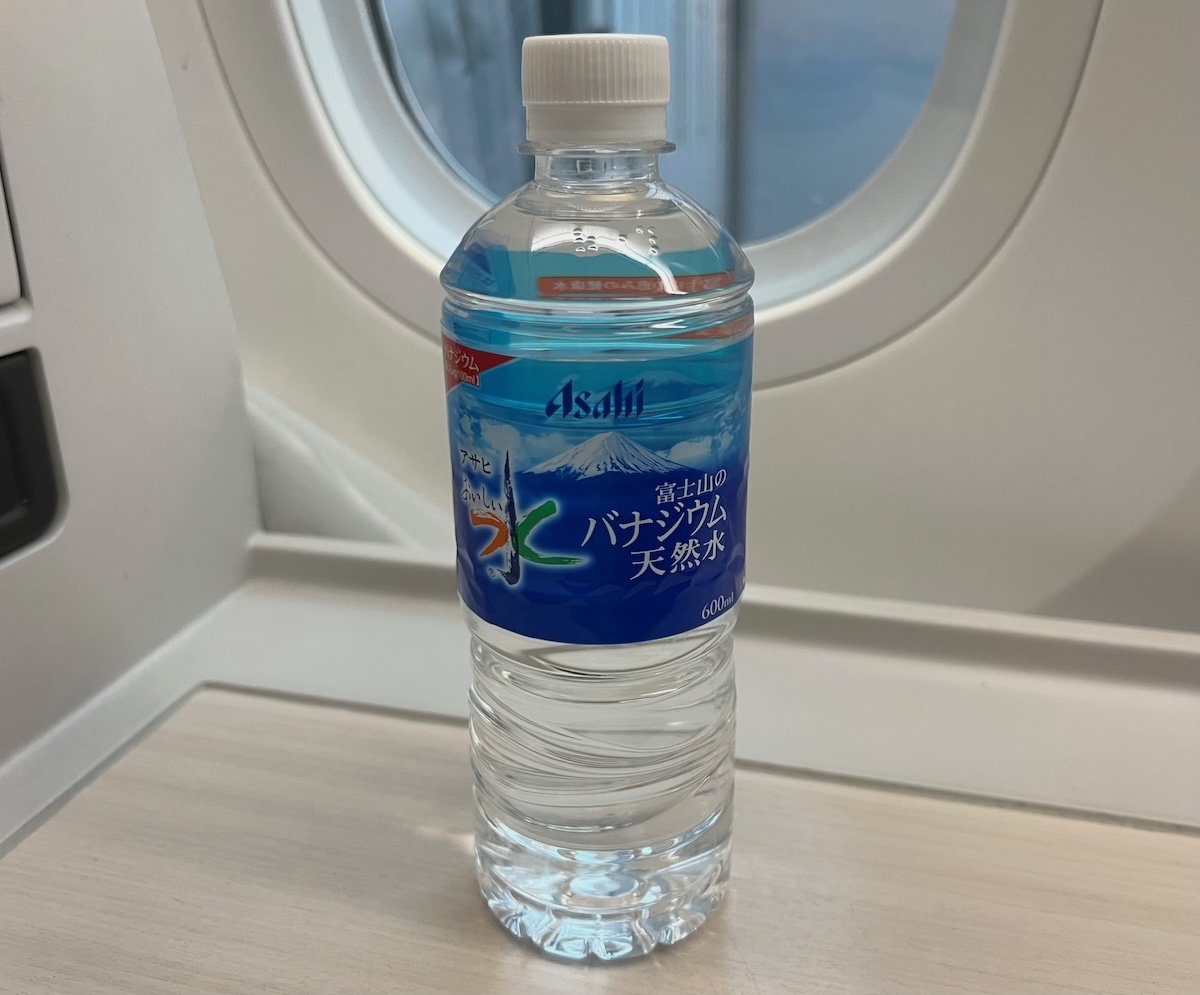
Last but not least, there was the menu for the flight. I’ve never really understand Japan Airlines’ branding when it comes to its food. What does “BEDD” stand for? And not to have the sense of humor of a 12 year old, but for whatever reason, I always read the menu as saying “sky aubergine.” Anyway…

During the boarding process, the friendly crew came through the cabin with pre-departure drinks, with the choice of champagne or orange juice. The pours definitely weren’t generous, and the drinks were served in (sturdy) plastic cups.

Last but not least, each business class passenger was offered a cardigan to borrow during the flight (they’re collected at the end of the flight). Since I’m usually warm on Japan Airlines aircraft, I’ve never actually had them on for an extended period of time.

Japan Airlines 787 business class entertainment & Wi-Fi
Japan Airlines’ Boeing 787s have 17″ seat back personal televisions, which aren’t particularly high resolution. For that matter, the interface doesn’t exactly seem cutting edge.

Japan Airlines’ entertainment selection is severely lacking, especially if you’re looking for English movies and TV shows. I couldn’t figure out exactly how many movies and TV shows there were, as many were listed multiple times, but let me simply say that the selection was limited. In particular, there was a lack of sitcoms in English, which you usually even find on other airlines with limited selections.

In addition to movies and TV shows, there were also news, audio, and game options.



I don’t usually watch movies (either on the ground or in the air), but I ended up watching “No Hard Feelings,” which I thought was pretty funny.

The inflight entertainment also had a map feature, which I otherwise kept an eye on during the flight.

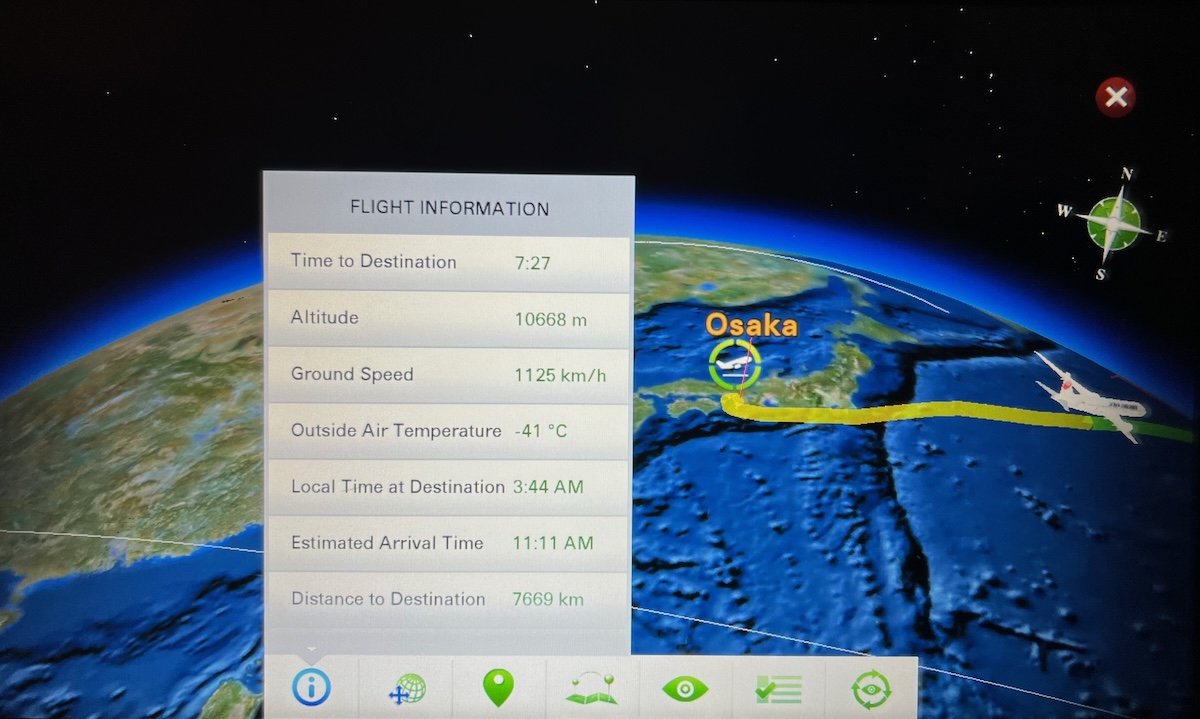
One thing to be aware of is that the entertainment screen doesn’t initially appear to be touchscreen, and at first forces you to use the little monitor to the side of the seat to make your selection, which is super clunky and annoying.
However, you can change the settings on the screen so that you can browse the selection directly on the main monitor, and I’d recommend doing that. If you can’t figure out how to do it, just ask a crew member.
While Japan Airlines’ inflight entertainment is weak, fortunately the carrier has Wi-Fi, which is reasonably priced. Japan Airlines uses Panasonic for its Wi-Fi, which has pretty good speeds across the Pacific.

There are three different pricing plans, all with no data limits. You can buy a one hour pass for $10.15, a three hour pass for $14.40, and a 24 hour pass for $18.80. Obviously the incremental pricing for the full flight plan is quite good.

I found connectivity to be consistent throughout the flight, and I also liked how you could switch between devices with one pass.
Japan Airlines 787 departure from Osaka
Boarding was outrageously efficient. It started at 5:20PM, and the main cabin door closed at 5:35PM, just 15 minutes later. Okay, in fairness, the flight wasn’t very full — while business class was full, both premium economy and economy seemed to be less than half full.
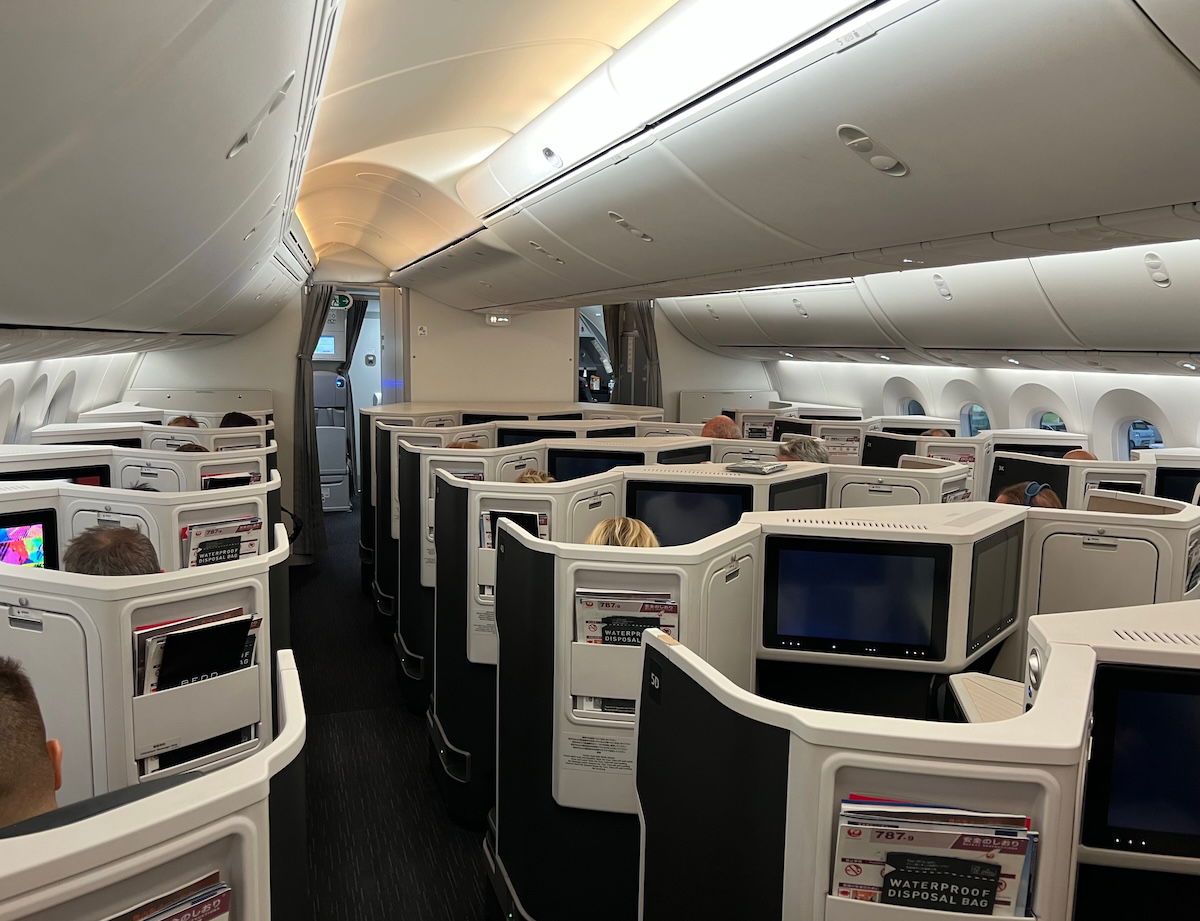
Once the door closed, the senior cabin attendant made her welcome aboard announcement, informing us of our short flight time of just 9hr20min. At 5:40PM we began our pushback, and a few minutes after that, the safety video was screened. We started our taxi at 5:45PM, and by 5:50PM we were cleared for takeoff on runway 6R. Talk about an efficient departure, as it was 30 minutes from the moment we boarded until we were airborne!

We had a smooth climb out, and the seatbelt sign was turned off just five minutes after takeoff.

Japan Airlines business class dinner service
On this flight, dinner was served after takeoff, while breakfast was served prior to landing. For dinner, there was the option of a Japanese or Western menu, and you can find those options below. Also below is the “anytime you wish” snack menu, along with the drink list.





Around 20 minutes after takeoff, service began with packaged towels being distributed. I’m not sure if this is supposed to be more sanitary, or what…
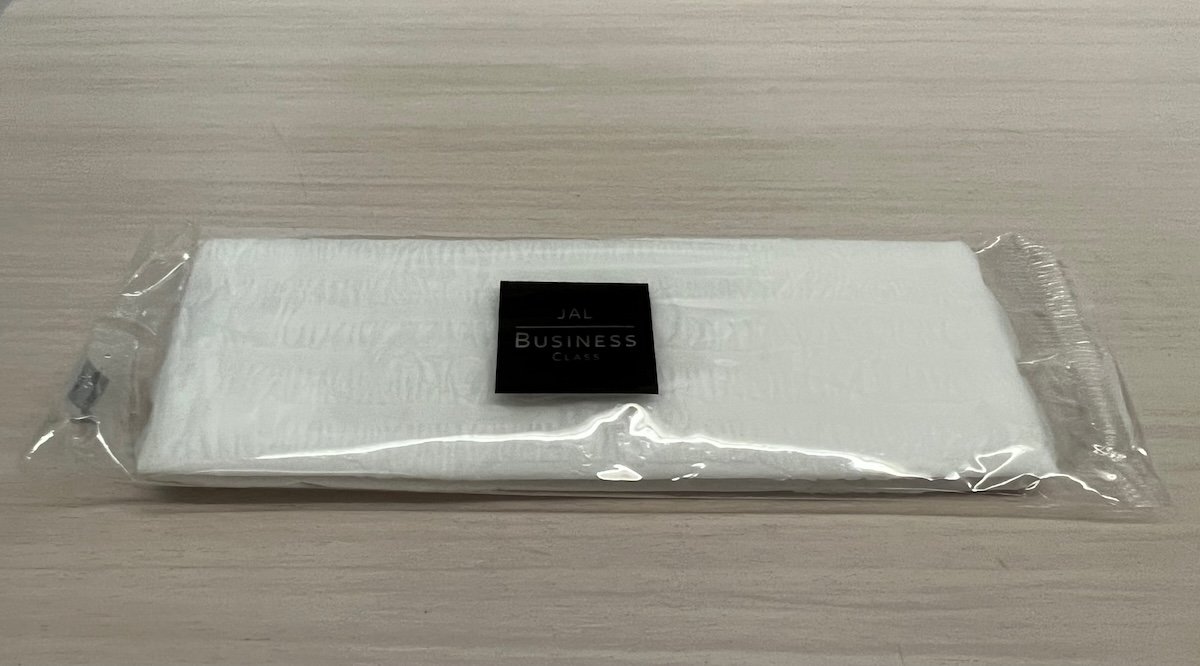
Meal and drink orders were taken around 30 minutes after takeoff, and a few minutes after that, tablecloths were distributed. The first round of drinks was served around 45 minutes after takeoff. To drink, I ordered a glass of champagne, and Duval-Leroy Brut Reserve was on offer, and it was poured directly at my seat.
I also ordered SKY TIME, Japan Airlines’ signature non-alcoholic drink, since I had never tried it before. The drinks were served with ramekins of both mixed nuts and olives — it’s always nice to have some non-packaged snacks with the first drink service!
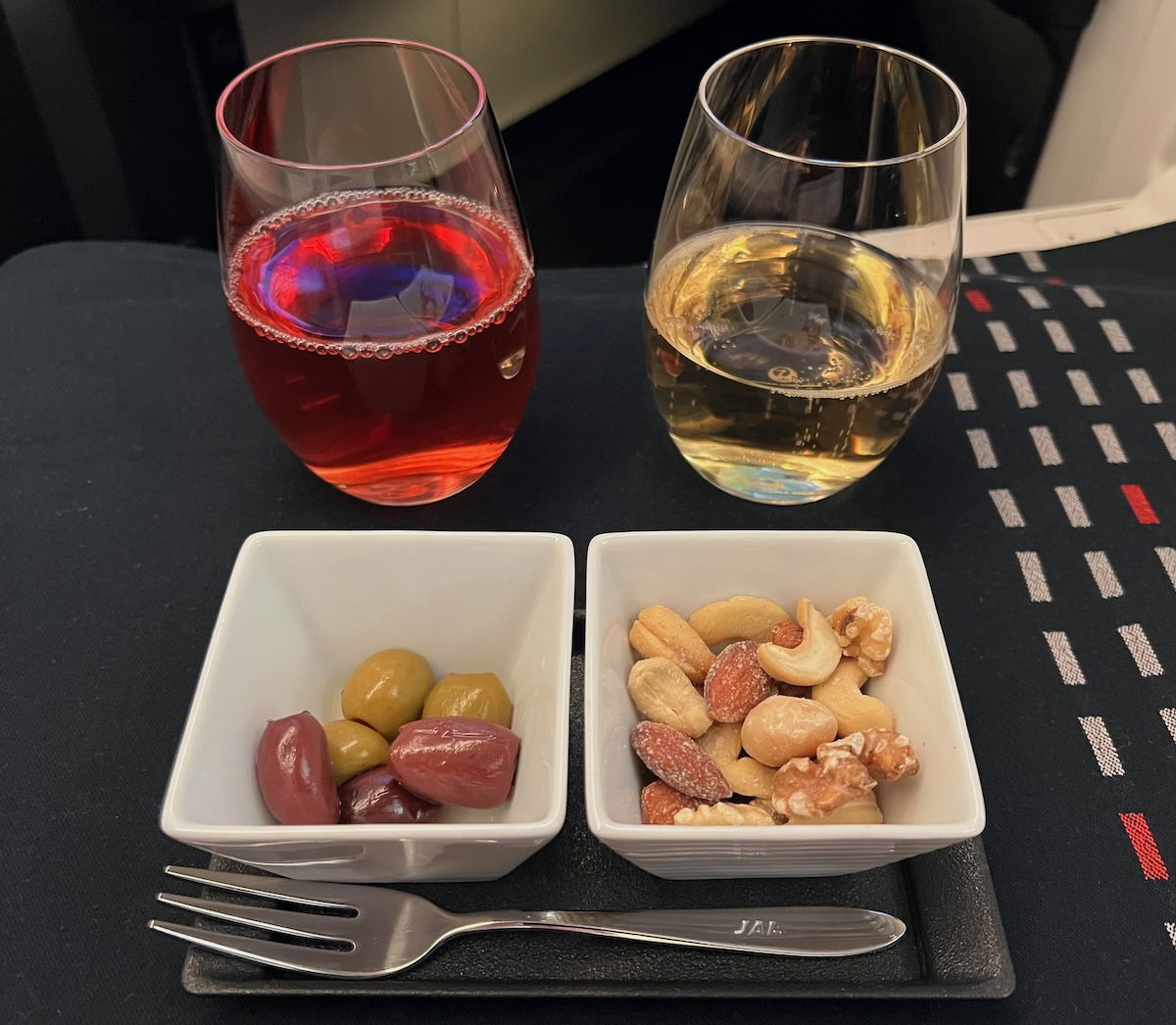
I decided to have the Japanese meal, and the first course was served around 60 minutes after takeoff. This consisted of scallops, tofu, lobster, horse mackerel, and poached pike conger, among other things, and was tasty.

The main course was served around 80 minutes after takeoff, and consisted of eel, steamed rice, miso soup, and Japanese pickles.

Once my main was cleared, I was offered dessert, which consisted of apple mango cake and green tea. It was an excellent meal, and the service was complete less than two hours after takeoff.

Ford was initially just going to sleep after takeoff, but ended up ordering a couple of dishes from the snack menu instead. Specifically, he ordered the fried bean curd and vegetable salad, and the wagyu curry.

Japan Airlines does a great job with its inflight meals, and we both enjoyed what we were served.
Japan Airlines 787 business class lavatories
Japan Airlines has three business class lavatories on the 787-9, with one being at the front of the cabin, and two being behind the cabin. All the lavatories were pretty standard Dreamliner ones.


While the lavatories weren’t particularly large, they were consistently clean, they had bidet toilets, and they also had some practical amenities, like dental kits and mouthwash.


Japan Airlines 787 business class bed
After dinner, it was time to get some rest, so I reclined my seat into bed mode.


As soon as I made my bed, the crew ran to my seat and gave me a mattress pad, which was nice and thick, and made a big difference with padding.

While the surface was soft thanks to the mattress pad, other than that, I found the bed to be quite uncomfortable. For one, the seat felt really narrow in bed mode, noticeably narrower than your typical reverse herringbone seat. As a side sleeper, I found it difficult to get comfortable, as there was no space to bend my knees.
I ended up falling asleep with a little over seven hours remaining to Los Angeles, and woke up a bit over two hours out. So I got nearly five hours of rest, which is quite good, though it was on and off, and I woke up several times.
Also, maybe I’m just getting old, or maybe it’s the seat, but I think due to the combination of the non-optimal seat and the pillow, when I woke up, my hands hurt, my back hurt, etc. Oh well, at least I’m lucky to be in a premium cabin, since it would’ve been much less comfortable in economy!

Japan Airlines business class breakfast service
Around two hours before arrival, the crew started turning on the cabin lights, given that pre-landing meals have to be ordered at least 90 minutes before landing. Japan Airlines has a pretty flexible dining concept in business class, as you can order off the breakfast menu, or off the snack menu. You can find the pre-arrival menu below.

I ordered just over 90 minutes before landing, and was served about 10 minutes later. I selected the Japanese breakfast, consisting of halibut with steamed rice, miso soup, and Japanese pickles. I had a cup of coffee to go along with it, which I enjoyed.

I was asked if I wanted any dessert, so I figured I might as well try the milk tea tart Haagen-Dazs ice cream, which was served in a little container.

Japan Airlines business class service
Service is generally very good on Japanese airlines, and this flight was no exception. The crew was friendly, attentive, had attention to detail, and spoke English well.
The service was even a bit less rigid than I remember on some past Japan Airlines flights, in a good way. That’s to say that during the meal service, I didn’t feel like I was simply part of an assembly line, but rather they’d offer drink refills when they saw an empty glass, would clear plates as each passenger finished, etc.
Speaking of service, about an hour before landing, one of the flight attendants distributed a “steam eye mask” to each passenger. It’s always cute to see the kinds of treats sometimes handed out on Japanese carriers.

Japan Airlines 787 arrival in Los Angeles
Around 45 minutes before landing, the captain was on the PA to announce that we’d be arriving at 11:10AM local time. While we had spent the entire flight out over the Pacific, we made landfall just south of the Bay Area, and then had stunning views as we flew south over California.
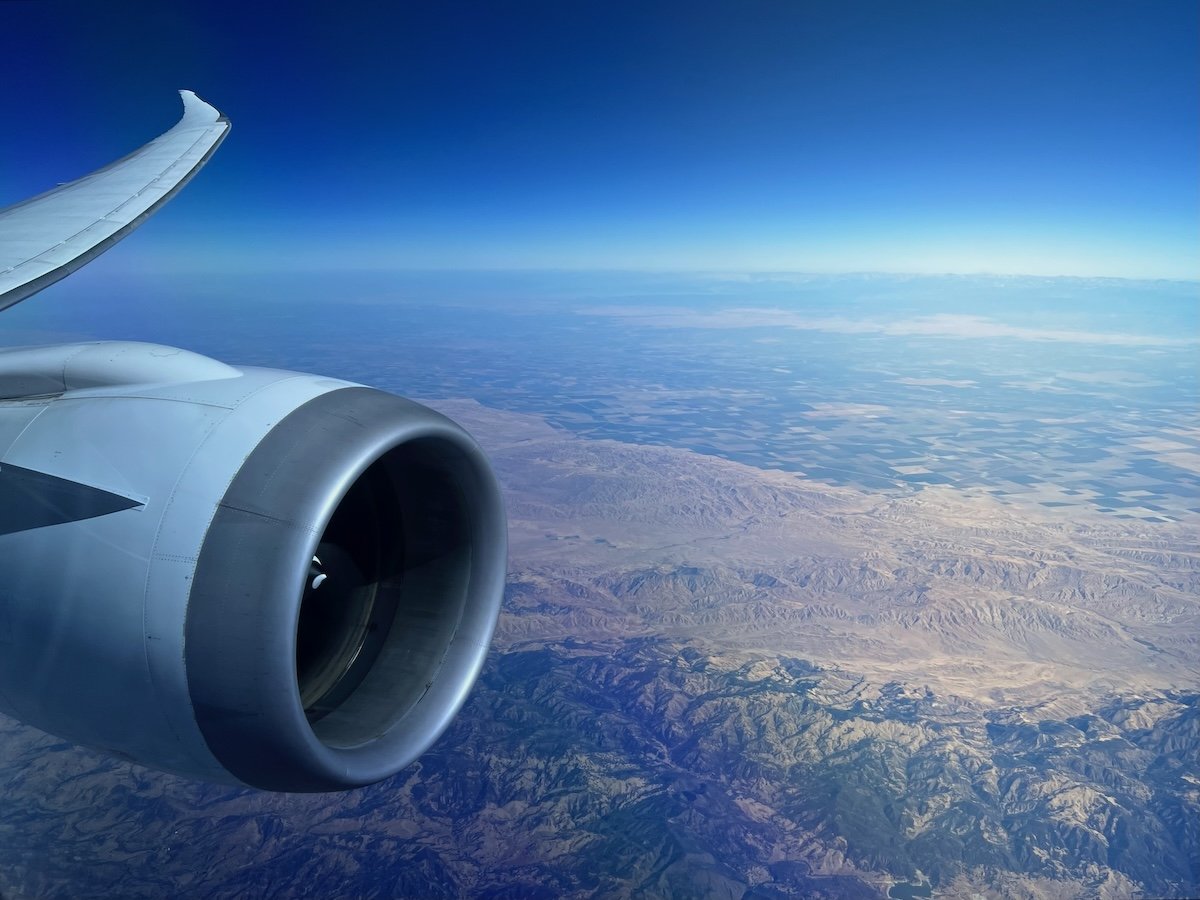


Our approach was smooth, and around 15 minutes before landing, the seatbelt sign was turned on. We touched down on runway 24L at 11:10AM.
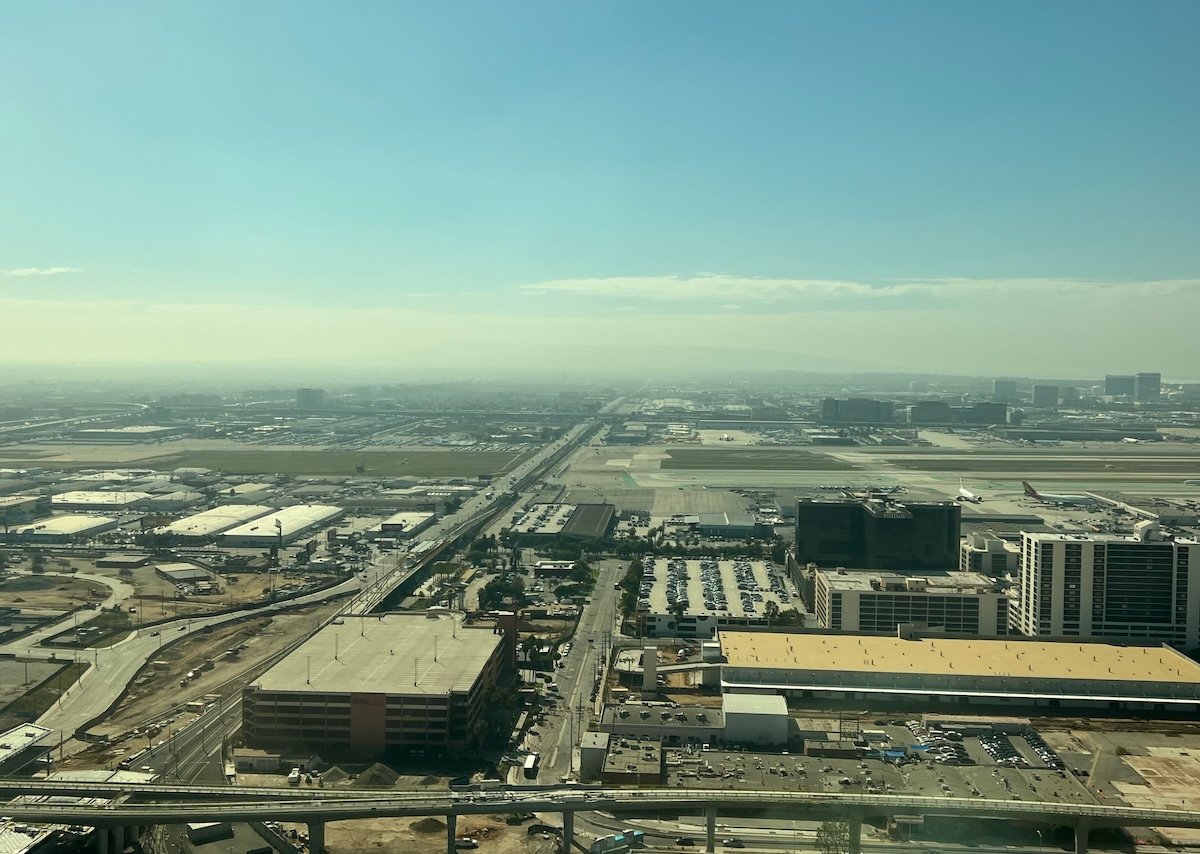


After landing, we had a roughly 10 minute taxi to our arrival gate, which was located on the other side of Tom Bradley International Terminal.

Specifically, we arrived at gate 155, where we parked next to a Japan Airlines Boeing 777-300ER. We were 45 minutes early, meaning we’d have plenty of time to make our connection.

Upon arrival we bid farewell to the crew, cleared immigration and customs, and headed over to Terminal 4, where we’d be flying American’s 787 business class to Miami.
Bottom line
I have mixed feelings about our Japan Airlines experience. On the one hand, the service was friendly, food was good, and Wi-Fi was reliable. Furthermore, I appreciated some of the amenities, like a mattress pad. On the other hand, this version of Japan Airlines’ business class seat is quite subpar, and is much worse than the carrier’s Apex Suites.
So while I generally love Japan Airlines business class and rank it among the best in the world, that doesn’t apply to the aircraft with these seats. I’d generally avoid this product if possible, unless you’re in a situation like we were in, where it’s the only nonstop option.
What’s your take on Japan Airlines’ Boeing 787 business class?
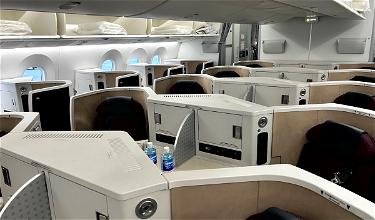




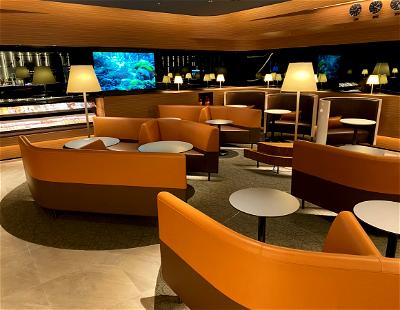











I recently flew this exact product HNL-HND.
I agree w/ everything except our service was awful.
Besides being very regimented, my parents and I found the business class FAs rude (the premium economy ones were very nice), especially the senior one in the white coat which sort of set the tone for the rest of the crew. I initially thought it might be a language issue, but there were too many examples that gave...
I recently flew this exact product HNL-HND.
I agree w/ everything except our service was awful.
Besides being very regimented, my parents and I found the business class FAs rude (the premium economy ones were very nice), especially the senior one in the white coat which sort of set the tone for the rest of the crew. I initially thought it might be a language issue, but there were too many examples that gave us a very bad impression.
The seat was very uncomfortable and claustrophobic (I still can't figure out why because it looks the same as most reverse herringbone seats) and the IFE system is not intuitive and clunky.
I flew DL and my parents flew HA back and the service was so much better than JAL. It was my first unpleasant experience on an Asian airlines.
Last time I flew on JAL from the US to Tokyo, they gave out cardigans to take home. Strange that you have to borrow them for the flight now.
@Ben, I'd imagine this is product is still preferred over UA's Polaris seat on KIX-SFO.
no, you didn't!
Having just flown this seat after flying AF’s new business class seat in bulkhead row 9 and the VS A350 seat in bulkhead row 1 (and having previously flown Polaris numerous times as well as AC Signature, AF BEST J, VS herringbone J, OS 777 throne seat, EVA 777 J, and both ANA and JAL F), I think this review dramatically overstated how cramped the seat is. I had no problem sleeping from right after...
Having just flown this seat after flying AF’s new business class seat in bulkhead row 9 and the VS A350 seat in bulkhead row 1 (and having previously flown Polaris numerous times as well as AC Signature, AF BEST J, VS herringbone J, OS 777 throne seat, EVA 777 J, and both ANA and JAL F), I think this review dramatically overstated how cramped the seat is. I had no problem sleeping from right after dinner until breakfast, and I’m a pretty wide person. The seat is a perfectly fine J seat for 10+ hour flights. I also run pretty warm but still wore the cardigan
Having flown five Premium Economy segments between LAX and MEL on Qantas since Australia reopened, I was grateful to fly round trip on JAL 787 LAX to KIX.
It's nice for me to have comparative benchmarks like Qantas Premium Economy for appreciating the quality of the JAL seats between LAX and KIX on the 787.
I can think of high quality Business Class seats like Singapore Air A350 between Seattle and Singapore as...
Having flown five Premium Economy segments between LAX and MEL on Qantas since Australia reopened, I was grateful to fly round trip on JAL 787 LAX to KIX.
It's nice for me to have comparative benchmarks like Qantas Premium Economy for appreciating the quality of the JAL seats between LAX and KIX on the 787.
I can think of high quality Business Class seats like Singapore Air A350 between Seattle and Singapore as a special flying experience by itself. Am glad it didn't diminish my subjective experience on the JAL LAX to KIX redemptions I was fortunate to find.
Hey Ben - in terms of booking, how far out did you find availability for the saver 60,000 level for JAL Business with AA?
I have been trying to find any cabin on JAL for SFO-TYO in March 2024 with an AA award ticket since the 11 month window opened up in April 2024 and it has been nothing! I know it is cherry blossom season but sheesh - they could release a few economy seats at least. Now I'm hoping something may open up last minute...
It's too bad KIX doesn't have the traffic/yields to support nonstop service to the U.S. Kansai is a very nice efficient airport.
Most US carriers have tried to make KIX work with little success. I think DL was the last (and NW prior) with service to HNL. Not sure if it was restored post-pandemic.
“It's too bad KIX doesn't have the traffic/yields to support nonstop service to the U.S.”
You mean other than the flight Ben just took and reviewed? I assume you mean support *more* nonstop service.
Love the name, BTW.
According to Google Flights HA flies HNL to KIX and UA flies SFO to KIX.
HA is by far the weakest US carrier right now. The weakness in the Japanese market because of the strength of the yen combined w/ WN's growth to/from/within Hawaii is providing financial challenges that HA likely will not be able to overcome.
The Japanese carriers have never been able to generate finances as strong as their US counterparts.
And UA generates far less profit per seat mile flying the Pacific than DL does.
HA is by far the weakest US carrier right now. The weakness in the Japanese market because of the strength of the yen combined w/ WN's growth to/from/within Hawaii is providing financial challenges that HA likely will not be able to overcome.
The Japanese carriers have never been able to generate finances as strong as their US counterparts.
And UA generates far less profit per seat mile flying the Pacific than DL does.
Everyone of the carriers flying from the US to Japan are for-profit companies but some do a far better job of making money than others.
You can afford to fly business class, and you are complaining about little things like cabin design, etc, etc. Wow! I've never been fortunate enough to be able to afford anything more than economy class, but I have always thoroughly enjoyed all of my more than 10 trips to Japan. The expectation of landing in Tokyo was great. No airline food is perfect, but be thankful you can eat!.
"You can afford to fly business class, and you are complaining about little things like cabin design, etc, etc. Wow!"
Clearly you're new here. Welcome to OMAAT!
Why are you even on this website in the first place? If someone spent their money/points on such a flight, they're allowed to prefer one carrier/seat to another. And this information helps people decide.
Secondly, you throw shade at Ben for being able to fly business class and make out how over privileged he is and imply he is a bad person, and then in same comment drop that you've flown to Japan ten times....
Why are you even on this website in the first place? If someone spent their money/points on such a flight, they're allowed to prefer one carrier/seat to another. And this information helps people decide.
Secondly, you throw shade at Ben for being able to fly business class and make out how over privileged he is and imply he is a bad person, and then in same comment drop that you've flown to Japan ten times. Seriously? Pot, kettle, black....
Next, if you have been able to afford to fly to japan ten times, you could have flown less times and instead of flying economy you could have flown business class.
The great AA redemption values make me disappointed I missed the SimplyMiles promotion last year. Aeroplan charges 70k for SFO-LIS while AA charges 60k for Japan-US business class and 85k for US-India business class on Qatar. There is so much value in AA miles.
That JAL pillow is way too thin even for Japanese like me, so I think it is not because of cultural preferences.
KIX does not receive much love from JAL as lower-yield, more leisure-oriented market (still better than ANA, which only flies to China from KIX), so that is why lounge, seat are subpar compared to their flight originating from Tokyo.
When are you flying the new JAL first class product ?
the planes aren't even flying yet.
Ben wrote that he is hoping to fly it in January.
Since the new seats will apparently have a surcharge it seems unlikely they'll be open for redemptions, at least for a while. Not to worry, Ben is wealthy enough to pay cash for one so we can check it out ASAP.
@Pete - Ben wrote that he has already made speculative bookings.
In my opinion, this seat is great and has room for you to actually put stuff during the flight. I slept very well, and Ben did sleep 5h.
Very uninspiring looking Cabin and Service. I have always found that airlines of Asia are overrated. I have never been satisfied with them and actually find them quite poor. I would like to see a larger focus placed on customer service and innovation with respect to Cabin design. They fail to understand that while asians are abnormally small, the rest of the world is not, thus peoe are packed in like sardines in a tin...
Very uninspiring looking Cabin and Service. I have always found that airlines of Asia are overrated. I have never been satisfied with them and actually find them quite poor. I would like to see a larger focus placed on customer service and innovation with respect to Cabin design. They fail to understand that while asians are abnormally small, the rest of the world is not, thus peoe are packed in like sardines in a tin can onboard the Asian airplanes.
The food is also horrendous and not at all enjoyable. Once again, catering only to asians as opposed to the rest of the world.
“The food is also horrendous and not at all enjoyable. Once again, catering only to asians as opposed to the rest of the world.”
There is a western menu. Ben just didn’t review it. FWIW, I’ve always enjoyed JAL’s Japanese menus. But I’m not narrow-minded.
How dare a Japanese airline cater to Japanese. The nerve.
Given that there’s far more Asians than people of any other ethnicity, perhaps you should reconsider your point of view and you’ll find that others are abnormally big?
I think most of the airlines just chose the models presented by seat makers (Safran, Zodiac, Collins etc) so there could not be huge differences between Asian and non-Asian airlines in terms of business class seat width/length.
And typically Asian airlines provides more generous legroom for economy seats - Japanese airlines provides 33-34 inch while Delta provides 31-32 inch and Lufthansa provides 31 inches.
This has to be one of the most laughable/ignorant comments on here. Legacy Asian airlines generally have more pitch in economy than their western counterparts despite catering to smaller people. Asian carriers generally have at least 32,", with NH/KE/OZ/JL all having 34" in economy (as opposed to western airlines which are almost always 30"- 31"). There really isn't much variation in terms of seat size in business/first across the board because products are pretty standardized....
This has to be one of the most laughable/ignorant comments on here. Legacy Asian airlines generally have more pitch in economy than their western counterparts despite catering to smaller people. Asian carriers generally have at least 32,", with NH/KE/OZ/JL all having 34" in economy (as opposed to western airlines which are almost always 30"- 31"). There really isn't much variation in terms of seat size in business/first across the board because products are pretty standardized. You also ignore the fact that airlines like CX/SQ/NH are generally innovators in terms of their premium products. Your comment about Asian food is a matter of personal taste and based on your surname, reads like someone who grew up on a diet of fried pork and fast food. If you don't like the Asian food, then get the Western options. What's "horrendous" to you is actually considered normal to the majority of the world.
The product on the 787 is reflective of the relatively small market from secondary (non-Tokyo) locations to the US and the load was even worse than normal considering how strong the Japanese Yen is compared to the USD. As much as United wants to argue otherwise, actual data shows that traffic between the US and Japan is down 20%, the largest drop between any major East Asian countries except for China and HKG. The US...
The product on the 787 is reflective of the relatively small market from secondary (non-Tokyo) locations to the US and the load was even worse than normal considering how strong the Japanese Yen is compared to the USD. As much as United wants to argue otherwise, actual data shows that traffic between the US and Japan is down 20%, the largest drop between any major East Asian countries except for China and HKG. The US is simply not an economically viable travel option for nearly as many Japanese as it used to be. Given that there are typically far more Japanese tourists inbound to the US vs. Americans visiting Japan, the strong dollar is hurting inbound Asian tourism much more so than to/from Europe which is heavily outbound American-driven.
KIX is a difficult market and a very limited one, for flights to and from the US. The product reflects it.
Feels like everybody and their mother (including me and mine) have been going to Japan since it reopened! Some people even twice within a year! Surprised traffic is down by that much, but your point around Japanese tourists makes sense.
I don't think UA cares all that much if traffic overall is down 20% so long as they maintain their market share for business travelers (who care probably less sensitive to currency fluctuations than tourists)
business travelers make up only a portion of the total revenue on a flight and that is true of Japan. The volume of total passengers is boosted by the value of the Yen relative to the dollar and the weak yen makes travel to the US not viable for most Japanese right now.
UA keeps Japan working because Tokyo is also a hub through their JV partner which means that they are carrying passengers...
business travelers make up only a portion of the total revenue on a flight and that is true of Japan. The volume of total passengers is boosted by the value of the Yen relative to the dollar and the weak yen makes travel to the US not viable for most Japanese right now.
UA keeps Japan working because Tokyo is also a hub through their JV partner which means that they are carrying passengers on their US to Japan flights that are connecting elsewhere - and the same is true for the Japanese carriers.
UA's decision to drop NRT-HNL as well as to ask to replace IAH-NRT w/ IAH-HND shows that the reduced local market is being felt at every Japanese airport but, because HND is the only one that is frequency limited w/ the US, it is the only one that is worth holding onto.
KIX has never acted as a hub comparable to the two Tokyo airports.
I'm curious as to why the multiple seat types and configurations. Like with the 789, you have the reverse herringbone as well as the Apex suites.
@ Mike O.: not sure of the original reasoning behind JAL having different seats - perhaps cost, maybe the Apex seats weren’t available yet, or maybe the density.
But as to why JAL keeps the two different types of layouts - as Tim pointed out, it is a less premium product used on a less premium route. JAL also uses the reverse herringbone 789s on intra-Asia mid-haul flights like NRT-SIN. (Though it uses Apex 789s...
@ Mike O.: not sure of the original reasoning behind JAL having different seats - perhaps cost, maybe the Apex seats weren’t available yet, or maybe the density.
But as to why JAL keeps the two different types of layouts - as Tim pointed out, it is a less premium product used on a less premium route. JAL also uses the reverse herringbone 789s on intra-Asia mid-haul flights like NRT-SIN. (Though it uses Apex 789s on HND-SIN.) I found the reverse herringbone seat to be fine for a 6 hour NRT-SIN flight. Though I think I am shorter than Ben and don’t have the same footwell complaint he does.
Ben sorry to bother I know time goes fast but I think it’s 2023
@ Konrad -- Whoops, thank you! Fixed.
In the center seats, the person on the left will effectively sleep on the floor. I like the idea but having been through this it does feel weird. Like a mandated peeping Tom position.
"can we just acknowledge how bland Japan Airlines’ cabin finishes are? Could you pick duller finishes than this?"
I'd argue that IB's interiors (grey seats/consoles/entire cabin basically) take the cake... the new J on the A350s feature some (faux presumably) wood on the center console, but it isn't much better
JAL business class is overated. I think you were overly generous prasing their soft product, which, based on my experience of many flights with them, is on par with their hard product. The service is mechanical and the food, while nicely presented, is bland.
@ Regis -- Not necessarily disagreeing, but just curious, which airlines do you think have non-mechanical service and non-bland food?
Hi Ben, Qatar and Malaysian.
Cabins look bland but overall, that looks a lot better than anything you will get on a US carrier.
Nice review as usual, Ben. Will add this config to the black list...
Speaking of JL's 787s, does KIX-LAX normally see 789 with Sky Suite III? I was somehow under the impression that Sky Suite III (mainly if not exclusively onboard 789) is for regional flights such as TYO-SIN. It would make sense with such density and space for an intra-Asia flight. Sky Suite (Apex) is the predominant on US flights, i.e. 773/789 (TYO-BOS/LAX/ORD).
It is mainly for regional flights but KIX-LAX always gets subpar seats, I think it was one of the last routes with JAL’s old angle flat seats. KIX generally is a pretty low yield airport, so it’s not going to get a low density, spacious product
@ Terence -- Yeah, unfortunately this route does regularly get this product, I suspect due to the lack of competition in the market, plus it being more leisure oriented.
Hmm... I wonder why they haven't introduced Zipair in Osaka then
Probably not enough travelers on the routes in general, KIX is just a smaller market (in addition to being leisure oriented) too
The plane cycles through Haneda-Honolulu-Osaka-Los Angeles-Osaka-Honolulu-Haneda. Yes it is always Skysuite III.
There are no planes based in KIX, so they need to find a logic to cycle the planes in and out of KIX.